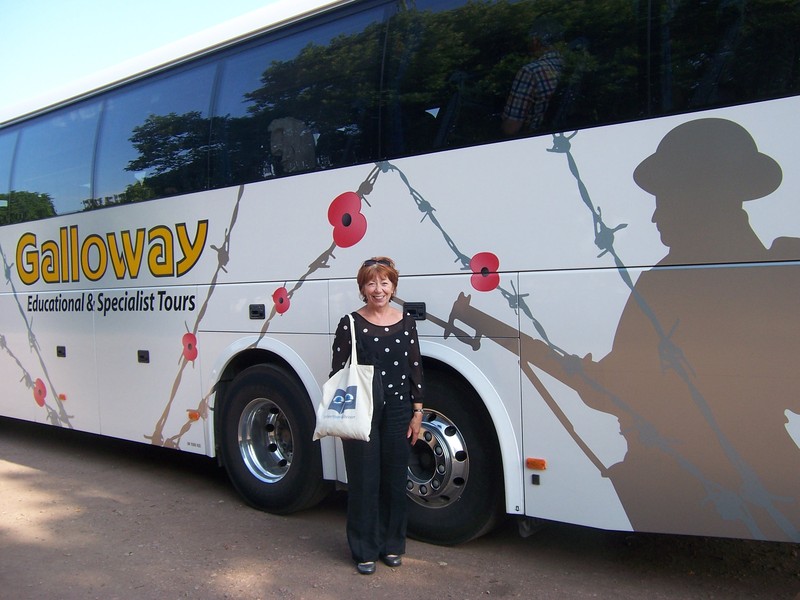The First and Last
9 million soldiers died, 20 million were injured with so many dying every day, from 1914 to 1918 it is easy to forget that these ‘statistics’ were human beings, that was the reality of this ‘lovely’ war.
The purpose of our visit by coach, was to see the First and Last British soldiers’ graves, the First to die in the ‘Great War’ and the Last to die, also to see the place where Wilfred Owen wrote some of his famous poetry. A short visit, just a ‘taster’ of the ‘battle fields’ including Arras and Mons in the 100th year Anniversary of the start of the ‘Great War’.
We travelled as guests of Tourisme Nord and Visit Mons.
 Our host was The Coach Tourism Council which has links to more than 100 British coach tour operators offering short breaks or escorted coach holidays to the WWI Battlefields. They include national operators such as Leger and Shearings, and by contacting them you can ‘Join the Coach Party’ that suits your ‘pocket and time’. There has been an increase in coach travelling for Silver Travellers, because it is comfortable, secure (ideal for single travellers) and with favourable prices, coach travelling has become very popular.
Our host was The Coach Tourism Council which has links to more than 100 British coach tour operators offering short breaks or escorted coach holidays to the WWI Battlefields. They include national operators such as Leger and Shearings, and by contacting them you can ‘Join the Coach Party’ that suits your ‘pocket and time’. There has been an increase in coach travelling for Silver Travellers, because it is comfortable, secure (ideal for single travellers) and with favourable prices, coach travelling has become very popular.
Our visit to the WWI sites started in London where we were picked up by the most amazing coach, which was from Galloways of Suffolk. It is an educational coach for groups and schools, taking trips to the WWI sights it was painted with poppies and a WWI soldier, not an easy coach to miss, but a lovely coach and an excellent driver/guide. We drove through London to the P&O Ferries terminal to sail from Dover to Calais, good sailing weather and a calm leisurely crossing. Tip: Go to the Club Lounge or the Bistro for excellent food and service, book online and enjoy a first class luxurious lounge, the cost is £12 extra and the lounge staff are very professional and welcoming to make the start or end of your trip a little special.
We stayed in Cambrai (France) for two nights to tour the area. Mons in Belgium was our first Battlefield site. Mons is a beautiful town today, street cafes selling excellent food, cobbled streets and the market full of beautiful flowers, 100 years ago this town was ravaged by war and the atrocities that the WWI brought. The Mons battle signified the first engagement between British and German forces on the Western Front and began on 23 August 1914.
Our first stop was the tourist information office and were shown a short film of the engagements that happened around Mons, a sobering, emotional film, (whatever you do on this trip do not forget your tissues!).
Our guide then took us to St Symphorien Military Cemetery to see the grave stones of the First and Last soldier to die in the ‘Great War’, a beautiful, tranquil cemetery, set out not in rows, but winding through gardens and woodland. The First solider to die was Private John Parr, a young man, sixteen years old. Parr specialised in becoming a reconnaissance cyclist – riding ahead to uncover information, he was shot on the 21st August 1914.
 The Last soldier to die was George Edwin Ellison, who died inThe Battle of Le Cateau (Mons) – 26th August 1918 – approximately 9,000 soldiers were killed or wounded on one day! The bridge at Nimy was where the Last soldier fell, he didn’t know the war had ended, no one knows if the soldier that shot him did.
The Last soldier to die was George Edwin Ellison, who died inThe Battle of Le Cateau (Mons) – 26th August 1918 – approximately 9,000 soldiers were killed or wounded on one day! The bridge at Nimy was where the Last soldier fell, he didn’t know the war had ended, no one knows if the soldier that shot him did.
The memorial to Wilfred Owen, the poet, was our next stop. Owen wrote over 100 poems, he was an English poet and soldier, one of the leading poets of the First World War. His shocking, realistic war poetry about the horrors of the trenches and gas warfare are recorded and now inspire poets from all over the world. The memorial to Wilfred Owen is Forester’s House at Ors. The rear of the house has the cellar that shows how Wilfred and his comrades sheltered and then, as they tried to cross the Sambre-Oise Canal on the 4th November 1918, one week before the Armistice on the 11th November 1918, Owen and his comrades died.
The coach transported us to all these sites and it was a pleasure to be driven by an experienced driver, to sit back and look at the sites or just ‘snooze’ in between stop; that is the beauty of coach travel, no fuss, no worries over luggage or checking the maps, everything is organised, and you see so much more from the elevated seats. The hotels are of a good standard and the friendly atmosphere on the coach is infectious.
We visited the Commonwealth cemetery, the magnificent Canadian cemetery at Vimy Ridge a memorial park and monument to 11,285 Canadian soldiers who died. It has an amazing sculpture to walk around and you can take a walk down to the trenches and see the tight spaces that the soldiers had to stand or ‘sit in’ – if they were lucky -before going into battle.
 Arras, a beautiful town with lovely squares that hustle and bustle with buildings that were reduced to rubble in WWI and have now been restored to their former beauty. Twenty metres below the pavements of Arras, we descended to discover the Wellington Quarry (named after Wellington in New Zealand) and this is a place not to miss. In November 1916 the British started preparing for the 1917 spring offensive. British and New Zealand tunnellers connected up the town’s chalk extraction tunnels to create a real network of underground barracks large enough to accommodate 24,000 men who lived beneath the ground before the assault for 8 days. The miners enlarged the tunnels for the men below ground as they pushed their way nearer to the enemy – (tissues are a must here). It is a sad and moving place giving the visitor a ‘taste’ of how life must have been for thousands of men.
Arras, a beautiful town with lovely squares that hustle and bustle with buildings that were reduced to rubble in WWI and have now been restored to their former beauty. Twenty metres below the pavements of Arras, we descended to discover the Wellington Quarry (named after Wellington in New Zealand) and this is a place not to miss. In November 1916 the British started preparing for the 1917 spring offensive. British and New Zealand tunnellers connected up the town’s chalk extraction tunnels to create a real network of underground barracks large enough to accommodate 24,000 men who lived beneath the ground before the assault for 8 days. The miners enlarged the tunnels for the men below ground as they pushed their way nearer to the enemy – (tissues are a must here). It is a sad and moving place giving the visitor a ‘taste’ of how life must have been for thousands of men.
‘Deborah’ the D51 WWI Tank – yes, a tank with a name – but Deborah is special. We visited a small village called Flesquieres in the area of Cambrai where the tank has been lovingly restored by a war memorabilia enthusiast Philippe Gorczynski and friends who have also created a small ‘museum’ in commemoration of WWI. In the Cambrai sector the Hindenburg line, was a German stronghold and on 20th November 1917, nine battalions of the British Tank Corps launched an attack. Deborah was part of the battle and her history can be found in the WWI archives, but Deborah lives on with the help of Phillippe and his friends.
 On our last day we visited the newly opened Fromelles (Pheasant Wood) museum, a sad and graffic museum that encapsulates the Battle of Fromelles, the cemetery that is adjacent to the museum has the remains of British and Australian soldiers that were found in 5 mass graves. Through DNA testing, 75 bodies have been identified and all the dead soldiers where reburied with full military honours. A little way from the museum is the Australian memorial park, a statue of Sgt Simon Fraser, an Australian who rescued two men on the battle field. The statue is called the Cobber, when one soldier called out to him “Don’t forget me cobber” he didn’t and got both men out in safety.
On our last day we visited the newly opened Fromelles (Pheasant Wood) museum, a sad and graffic museum that encapsulates the Battle of Fromelles, the cemetery that is adjacent to the museum has the remains of British and Australian soldiers that were found in 5 mass graves. Through DNA testing, 75 bodies have been identified and all the dead soldiers where reburied with full military honours. A little way from the museum is the Australian memorial park, a statue of Sgt Simon Fraser, an Australian who rescued two men on the battle field. The statue is called the Cobber, when one soldier called out to him “Don’t forget me cobber” he didn’t and got both men out in safety.
This was an interesting, unforgettable journey, back to 1914, to see how WWI was such a cruel and bloody war that wiped out a generation of young men from the Commonwealth and Europe. We only had a ‘taster’ of these ‘War to End All Wars’ sites and we will return to discover more about this dreadful war and pay our respects to the soldiers that died, one of our party said ‘what a waste it was’? The poppies have had their season and are now dying, but what ever your age you can not help being moved by the WWI memorial sites, and 100 years on we are still remembering, but sadly we ‘never learn’ and the wars go on.











